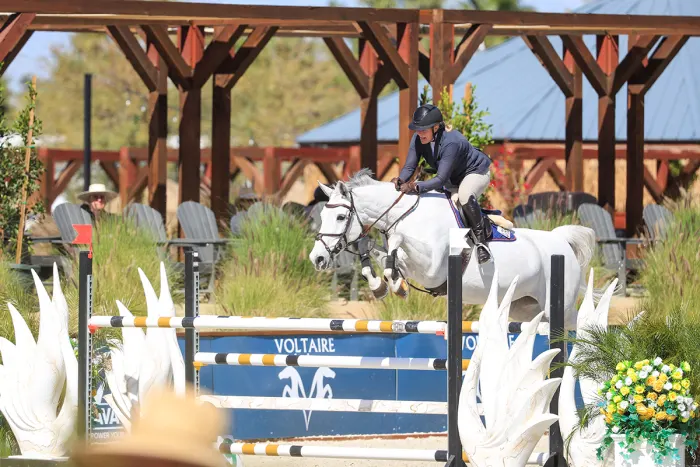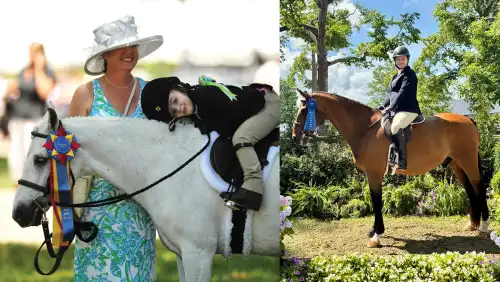Ever since equine veterinarian Lori Bidwell, DVM, DACVAA, CVA, was a little girl growing up on a farm in Grand Rapids, Michigan, horse welfare has been her No. 1 priority.
“Now there’s a sign hanging in my office that says, ‘We do this because we love horses,’ ” Bidwell said. “I think it’s important to remind people of that every day.”
She and her husband, Duncan Peters, DVM, MS, DACVSMR, have created their entire lifestyle around that philosophy. The couple has a small breeding farm, Five O’Clock Farm, in Lexington, Kentucky, where they raise young jumper prospects. They also own and operate a mobile veterinary practice, East-West Equine Sports Medicine, and divide their time between being the official show veterinarians at the Desert International Horse Park in Thermal, California, for the winters and the Great Lakes Equestrian Festival in Traverse City, Michigan, during the summers. Peters specializes in equine sports medicine, and Bidwell, a board-certified equine anesthesiologist, has turned her focus to acupuncture, massage therapy and general medicine.

“I love doing the acupuncture,” Bidwell said. “It looks at the whole body, and I can keep the sport horses feeling good without needing medications. It’s not perfect, but it’s nice to be able to help the horses feel their best.”
At the 2024 Capital Challenge Horse Show (Maryland), the couple was honored with the David Peterson Perpetual Trophy for their dedication and commitment to the care and well-being of horses.
Both Bidwell and Peters are also competitive on the hunter/jumper horse show circuit, traveling around the country with their four show horses. They currently own about 16 horses together, which are a mix of the young horses they bred that are in training to become successful jumper prospects, and more experienced horses that are stepping down to teach the next generation. Bidwell also competes in the 1.20-meter and 1.30-meter jumper divisions, as her work schedule allows, on her mares Nim and Fostyne. The couple train with Katie Monahan-Prudent when they’re on the East Coast, and Kyle King when they are on the West Coast.
Balancing her work schedule with riding and showing is a challenge, and Bidwell has learned through experience that she does best when she focuses on one or the other, despite often being at a show grounds with abundant opportunities to try to do it all.
Each week that Bidwell shows, she tries to choose a jumper class that goes at 8 a.m. She also aims to be the first rider in the ring so that she can be finished showing early and then can focus on her work for the remainder of the day.
“Some days we will see 40 cases a day in Thermal, [my work schedule] can be crazy busy,” she said. “I’ve learned the hard way that I cannot show and work at the same time. Last year, I was competing in the 1.30-meter and I won a class in the division, and then two days later I was going to try to do another 1.30-meter class, but we had people trying to jog horses for a Young Rider qualifier while I was trying to learn my course and watch, and it was too much all at once. My brain was not in the right place, and I rode so horribly and fell off.”
ADVERTISEMENT
After spending a week in agonizing pain and hauling her horses from Thermal home to her farm in Kentucky, Bidwell saw her doctor in Lexington and learned that she had fractured her pelvis in multiple places from that fall.
“That really reminded me that I need to ride and show only when my head is in a good place,” she said. “My husband and I agreed that when it’s so busy like that, we shouldn’t add us showing into the mix. So now I try to set myself up for success.”

If she is not showing, Bidwell and her husband will wake up and take the horses out on a morning trail ride or a hack before they start their work for the day.
“It makes our day so much better,” she said. “It’s not like we have to show—honestly sometimes just going for a trail ride or hack is the best.”
In addition, Bidwell is a sought-after teacher in equine anesthesiology, and she often travels the country to educate other veterinarians. She spent many years performing daily surgeries when she worked for several top veterinary surgical practices, including Rood and Riddle Equine Hospital (Kentucky), and she also taught equine anesthesia at the Michigan State University College of Veterinary Medicine.
“There are not many equine-specific anesthesiologists, so there’s definitely a need for teaching,” she said. “I’ve even gone to Ireland and Australia to teach. It’s really fun for me.”
And now, Bidwell has accepted a new task, being named to the U.S. Hunter Jumper Association as a director at-large representing amateur riders. A majority of the USHJA board meetings are held via Zoom, so the job is an easy addition for Bidwell to add to her schedule.
“I’m in my 50s now, and I finally feel like I have knowledge that I can give back to the equine industry,” she said, also referencing her experience riding in a variety of different disciplines like Western, saddle seat and hunt seat as a kid.
Her work as a show vet also has put her on the frontlines of disease outbreaks, having dealt with vesicular stomatitis outbreaks and working at Thermal during the 2021 equine herpesvirus-1 outbreak that ultimately shut down the California show season.
“I feel like [our governing body] does not always make decisions backed by science. I feel like it’s time that I’m a part of those decisions.”
ADVERTISEMENT
What she sees from uneducated people working in the barns at show grounds, she said, motivates her to look for ways to advocate for horses.
“I also want to help bring back horsemanship,” she said. “I feel like there are a lot of grooms that are hired [now] who aren’t horse people, and they ultimately don’t care about the horses. … When you drive around [the horse shows] on any given day, you can see grooms blasting the horses in the face with water from the hose [during bath time]. There aren’t many rules to protect the horses, and I think we need to do more on the welfare-side of things for the horses. I do not want to go creating a whole bunch of rules, but I do think we need to do something.”
“There aren’t many rules to protect the horses, and I think we need to do more on the welfare-side of things for the horses. I do not want to go creating a whole bunch of rules, but I do think we need to do something.”
Dr. Lori Bidwell
A focus on welfare is important not just to the animals, but to the long-term survival of horse sports, she noted, pointing to the growing importance of social license to operate.
“What does our industry look like to outsiders?” Bidwell asked. “Have we become habituated to behaviors that would be appalling or considered inhumane to people outside of our industry? Currently, this really matters because people outside of our industry are making laws and regulations that could end our sport.”
“The European equine federations are being aggressive with making changes to appease this concept,” she continued. “And the United States is behind on making changes that work towards improvement in equine welfare. It becomes more complicated because we have so many more breed and discipline organizations that have their own governing bodies. We need to make changes to our ‘normal’ practices quickly. That includes less medications, less longeing, less intense competition schedules and more downtime and rest for the horses. Horses were not meant to be in stalls 23 hours a day. We need to find ways to allow horses to be horses again.”
In addition to being on the USHJA Board of Directors, Bidwell hopes to have a voice on USHJA’s Young Jumper Task Force in the future. Many of the young horses that she and Peters breed go on to be successful jumper prospects, and Bidwell wants to ensure the continued success of the division in the United States.
“I’m very passionate about the young jumper divisions; I compete in those as well,” she said. “As a U.S. breeder, we don’t have a lot of outlets for selling young horses. For me personally, that’s frustrating because it’s so much fun [for us] to develop young horses.”
She’d like to see the age and jump height requirements of the young jumper divisions re-examined, she said, to ensure the program allows horses to develop appropriately for each individual.
“Right now, we have a 6-year-old jumper that got overfaced in the 5-year-olds in Europe, so we really had to back him off here,” she said by way of example. “There’s no way I could have shown him in the 6-year-old young jumpers here, because it’s pretty big for him, and he wasn’t quite ready for that. And now he’s a 7-year-old, and that means he has to jump 1.30 [meters]. So my goal is to find a way to really promote the young horses and make it affordable and appropriate for the way different young horses develop. That’s something I hope to have some input on and help with.”














